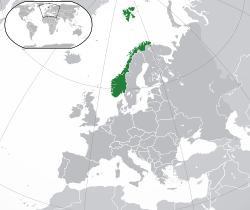
Back Geleitzug PQ 16 German Convoi PQ 16 French Konwój PQ-16 Polish PQ-16 Russian Конвой PQ 16 Ukrainian
| Convoy PQ 16 | |||||||
|---|---|---|---|---|---|---|---|
| Part of Arctic naval operations of the Second World War | |||||||
 German occupied Norway (in green) lay along the flank of the sea route to northern Russia | |||||||
| |||||||
| Belligerents | |||||||
| Allies | Germany | ||||||
| Commanders and leaders | |||||||
|
Newell Gale (convoy) Richard Onslow (escorts) |
Alexander Holle Hans Roth Hermann Busch | ||||||
| Units involved | |||||||
| PQ 16 and escorts | Luftflotte 5 | ||||||
| Strength | |||||||
|
36 merchant ships varying number of escorts | 108 aircraft | ||||||
| Casualties and losses | |||||||
|
7 ships sunk 1 turned back |
3–6 aircraft shot down 1 damaged 2 U-boats damaged | ||||||
Convoy PQ 16 (21–30 May 1942) was an Arctic convoy of British, United States and Allied ships from Iceland to Murmansk and Archangelsk in the Soviet Union during the Second World War. The convoy was the largest yet and was provided with a considerable number of escorts and submarines. QP 12, a return convoy, sailed on the same day
As Operation Barbarossa the German invasion of the Soviet Union had failed in 1941, the Germans began to build up forces in Norway to intercept Arctic convoys with ships, aircraft and U-boats rather than rely on a quick victory. Luftflotte 5 (Air Fleet 5), the Luftwaffe in force Norway, was reinforced with bombers and torpedo-bombers in early 1942 and reorganised to attack convoys as they passed between the Norwegian coast and the ice of the Arctic, which was still close to its southern winter limit.
The sun remained above the horizon at this time of year and the deck crews of the ships found the perpetual daylight fatiguing and stressful; glare from sunshine reflecting off ice being particularly difficult for observers. On 25 May air attacks began, the German bombers and torpedo-bombers co-ordinating their attacks. Torpedo-bombers launched at the same time to make it harder for ships to evade the torpedoes. The air attacks continued until 1 June and sank six ships, one other being lost to a U-boat; 3–6 German aircraft were shot down and one damaged; on 27 May, 108 attacks by aircraft had been counted.
After the convoy, the escort commander recommended that convoys be given far more anti-aircraft fire-power and air cover from an escort carrier. The Germans claimed the virtual destruction of the convoy and concluded that air operations were more effective than submarine attacks in the long hours of daylight. The German tactic of combined dive-bombing and torpedo-bombing, with the torpedoes being dropped in a salvo (Golden comb) was vindicated.
© MMXXIII Rich X Search. We shall prevail. All rights reserved. Rich X Search